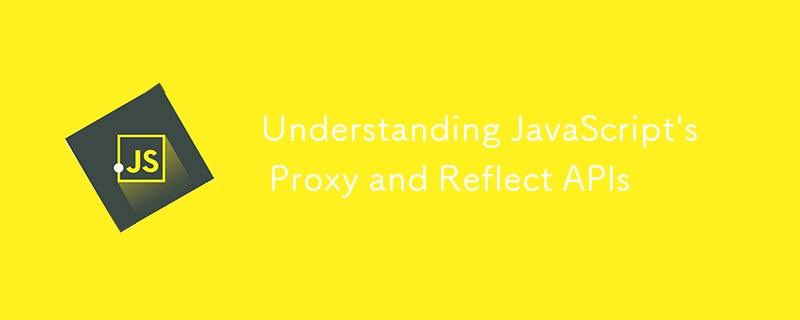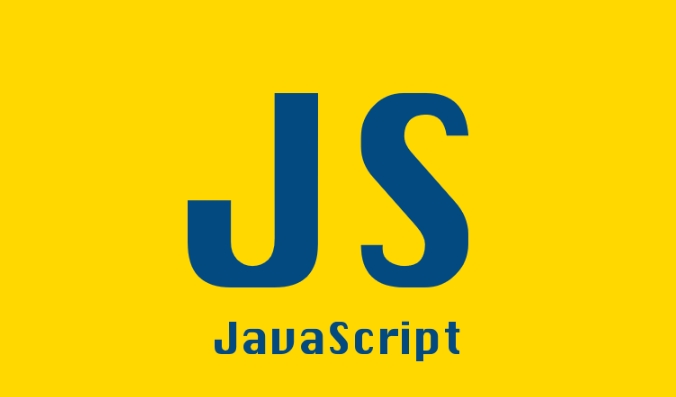Understanding JavaScript's Proxy and Reflect APIs
Proxy and Reflect APIs are powerful tools used in JavaScript to intercept and customize object operations; 1. Proxy blocks operations such as get, set by wrapping target objects and defining "traps", and implements functions such as logs, verification, read-only control; 2. Reflect provides methods corresponding to Proxy traps to ensure the consistency and correctness of default behaviors and improve code maintainability; 3. Practical applications include Vue 3 responsive systems, data verification, debug logs, immutable objects and API simulation; 4. Pay attention to performance overhead, complex behavior of built-in objects, this binding problems, and nested objects need to be recursively proxyed; 5. Reasonable use can build an efficient, debugable, and reactive system, but excessive use should be avoided to make the code difficult to understand.

JavaScript's Proxy and Reflect APIs are powerful features introduced in ES6 that allows developers to intercept and customize fundamental object operations. While they might not be used every day, understanding them give you deeper control over object behavior and enables advanced patterns like validation, logging, and reactive programming.

What is the Proxy API?
A Proxy lets you create a wrapper around an object that can intercept and redefine basic operations like reading properties, writing values, or checking if a property exists. Think of it as a "gatekeeper" for an object.
Basic Syntax:

const proxy = new Proxy(target, handler);
-
target: The original object to wrap. -
handler: An object defining which operations to intercept (called "traps").
Example: Logging property access
const user = { name: 'Alice', age: 30 };
const proxy = new Proxy(user, {
get(target, property) {
console.log(`Getting property: ${property}`);
return target[property];
},
set(target, property, value) {
console.log(`Setting property: ${property} = ${value}`);
target[property] = value;
return true; // Must return true for successful assignment
}
});
proxy.name; // Logs: Getting property: name
proxy.age = 31; // Logs: Setting property: age = 31This is useful for debugging, validation, or even building observables.

Common Proxy Traps
Here are some frequently used traps in the handler:
-
get(target, property)– Intercepts property reads. -
set(target, property, value)– Intercepts property writes. -
has(target, property)– Interceptsinoperator (eg,'name' in obj). -
deleteProperty(target, property)– Interceptsdelete obj.prop. -
apply(target, thisArg, args)– Used for wrapping functions. -
construct(target, args)– Interceptsnewoperator.
Example: Validation with set trap
const validatedUser = new Proxy({}, {
set(target, property, value) {
if (property === 'age' && typeof value !== 'number') {
throw new TypeError('Age must be a number');
}
if (property === 'name' && typeof value !== 'string') {
throw new TypeError('Name must be a string');
}
target[property] = value;
return true;
}
});
validatedUser.name = 'Bob'; // OK
validatedUser.age = 'thirty'; // Throws TypeErrorThis allows you to enforce data integrity at the object level.
What is the Reflect API?
Reflect is a built-in object that provides methods for intercepting JavaScript operations. It's designed to work hand-in-hand with Proxy . For every proxy trap, there's a corresponding Reflect method.
Instead of manually accessing target[property] in a get trap, use Reflect.get() — it keeps the default behavior consistent and handles edge cases.
Why use Reflect?
- Keeps code clean and predictable.
- Handles
thisbinding correctly. - Provides a functional way to perform object operations.
Improved Proxy using Reflect:
const safeObject = new Proxy({ value: 42 }, {
get(target, property) {
console.log(`Accessing: ${property}`);
return Reflect.get(target, property);
},
set(target, property, value) {
console.log(`Mutating: ${property}`);
return Reflect.set(target, property, value);
}
}); Using Reflect ensures that your proxy respects JavaScript's default behavior unless explicitly overridden.
Practical Use Cases
These APIs aren't just academic — they're used in real tools and frameworks:
- Vue 3's Reactivity System : Uses
Proxyto detect property access and updates, replacingObject.defineProperty. - Validation Libraries : Wrap objects to enforce type or range checks.
- Debugging & Logging : Monitor object interactions without modifying the original code.
- Immutable Wrappers : Prevent accidental mutations by throwing errors in
settraps. - API Mocking : Simulate objects with dynamic responses.
Example: Read-only proxy
function readOnly(target) {
return new Proxy(target, {
set() {
throw new Error("Cannot modify a read-only object");
},
deleteProperty() {
throw new Error("Cannot delete from a read-only object");
}
});
}
const config = readOnly({ api: 'https://api.example.com' });
config.api = 'hacked'; // Throws errorGotchas and Best Practices
- Performance : Proxies add overhead. Don't wrap large objects unless necessary.
- Not all objects can be proxied equally : Built-in objects like arrays have nuanced behaviors.
- Use
Reflectconsistently : It makes your traps more reliable and easier to maintain. - Proxies only wrap the outer object : Nested objects aren't automatically protected unless you recursively proxy them.
Final Thoughts
Proxy and Reflect open up meta-programming capabilities in JavaScript. While overuse can make code harder to follow, they're invaluable for building clean abstractions, debugging tools, and reactive systems.
Used wisely, they let you write code that's both powerful and expressive.
Basically, if you need to observe, control, or enhance how objects behave — Proxy and Reflect are the tools to reach for.
The above is the detailed content of Understanding JavaScript's Proxy and Reflect APIs. For more information, please follow other related articles on the PHP Chinese website!

Hot AI Tools

Undress AI Tool
Undress images for free

Undresser.AI Undress
AI-powered app for creating realistic nude photos

AI Clothes Remover
Online AI tool for removing clothes from photos.

Clothoff.io
AI clothes remover

Video Face Swap
Swap faces in any video effortlessly with our completely free AI face swap tool!

Hot Article

Hot Tools

Notepad++7.3.1
Easy-to-use and free code editor

SublimeText3 Chinese version
Chinese version, very easy to use

Zend Studio 13.0.1
Powerful PHP integrated development environment

Dreamweaver CS6
Visual web development tools

SublimeText3 Mac version
God-level code editing software (SublimeText3)
 Advanced Conditional Types in TypeScript
Aug 04, 2025 am 06:32 AM
Advanced Conditional Types in TypeScript
Aug 04, 2025 am 06:32 AM
TypeScript's advanced condition types implement logical judgment between types through TextendsU?X:Y syntax. Its core capabilities are reflected in the distributed condition types, infer type inference and the construction of complex type tools. 1. The conditional type is distributed in the bare type parameters and can automatically split the joint type, such as ToArray to obtain string[]|number[]. 2. Use distribution to build filtering and extraction tools: Exclude excludes types through TextendsU?never:T, Extract extracts commonalities through TextendsU?T:Never, and NonNullable filters null/undefined. 3
 Micro Frontends Architecture: A Practical Implementation Guide
Aug 02, 2025 am 08:01 AM
Micro Frontends Architecture: A Practical Implementation Guide
Aug 02, 2025 am 08:01 AM
Microfrontendssolvescalingchallengesinlargeteamsbyenablingindependentdevelopmentanddeployment.1)Chooseanintegrationstrategy:useModuleFederationinWebpack5forruntimeloadingandtrueindependence,build-timeintegrationforsimplesetups,oriframes/webcomponents
 How to find the length of an array in JavaScript?
Jul 26, 2025 am 07:52 AM
How to find the length of an array in JavaScript?
Jul 26, 2025 am 07:52 AM
To get the length of a JavaScript array, you can use the built-in length property. 1. Use the .length attribute to return the number of elements in the array, such as constfruits=['apple','banana','orange'];console.log(fruits.length);//Output: 3; 2. This attribute is suitable for arrays containing any type of data such as strings, numbers, objects, or arrays; 3. The length attribute will be automatically updated, and its value will change accordingly when elements are added or deleted; 4. It returns a zero-based count, and the length of the empty array is 0; 5. The length attribute can be manually modified to truncate or extend the array,
 What are the differences between var, let, and const in JavaScript?
Aug 02, 2025 pm 01:30 PM
What are the differences between var, let, and const in JavaScript?
Aug 02, 2025 pm 01:30 PM
varisfunction-scoped,canbereassigned,hoistedwithundefined,andattachedtotheglobalwindowobject;2.letandconstareblock-scoped,withletallowingreassignmentandconstnotallowingit,thoughconstobjectscanhavemutableproperties;3.letandconstarehoistedbutnotinitial
 Understanding JavaScript's Proxy and Reflect APIs
Jul 26, 2025 am 07:55 AM
Understanding JavaScript's Proxy and Reflect APIs
Jul 26, 2025 am 07:55 AM
Proxy and Reflect API are powerful tools used in JavaScript to intercept and customize object operations; 1. Proxy blocks operations such as get, set by wrapping target objects and defining "traps", and implements functions such as logs, verification, read-only control; 2. Reflect provides methods corresponding to Proxy traps to ensure the consistency and correctness of default behaviors and improve code maintainability; 3. Practical applications include Vue3 responsive system, data verification, debug logs, immutable objects and API simulation; 4. Pay attention to performance overhead, complex behavior of built-in objects, this binding problems, and nested objects need to be recursively proxyed; 5. Reasonable use can build efficient, debugable, and reactive
 Generate Solved Double Chocolate Puzzles: A Guide to Data Structures and Algorithms
Aug 05, 2025 am 08:30 AM
Generate Solved Double Chocolate Puzzles: A Guide to Data Structures and Algorithms
Aug 05, 2025 am 08:30 AM
This article explores in-depth how to automatically generate solveable puzzles for the Double-Choco puzzle game. We will introduce an efficient data structure - a cell object based on a 2D grid that contains boundary information, color, and state. On this basis, we will elaborate on a recursive block recognition algorithm (similar to depth-first search) and how to integrate it into the iterative puzzle generation process to ensure that the generated puzzles meet the rules of the game and are solveable. The article will provide sample code and discuss key considerations and optimization strategies in the generation process.
 What is optional chaining (?.) in JS?
Aug 01, 2025 am 06:18 AM
What is optional chaining (?.) in JS?
Aug 01, 2025 am 06:18 AM
Optionalchaining(?.)inJavaScriptsafelyaccessesnestedpropertiesbyreturningundefinedifanypartofthechainisnullorundefined,preventingruntimeerrors.1.Itallowssafeaccesstodeeplynestedobjectproperties,suchasuser.profile?.settings?.theme.2.Itenablescallingme
 How can you remove a CSS class from a DOM element using JavaScript?
Aug 05, 2025 pm 12:51 PM
How can you remove a CSS class from a DOM element using JavaScript?
Aug 05, 2025 pm 12:51 PM
The most common and recommended method for removing CSS classes from DOM elements using JavaScript is through the remove() method of the classList property. 1. Use element.classList.remove('className') to safely delete a single or multiple classes, and no error will be reported even if the class does not exist; 2. The alternative method is to directly operate the className property and remove the class by string replacement, but it is easy to cause problems due to inaccurate regular matching or improper space processing, so it is not recommended; 3. You can first judge whether the class exists and then delete it through element.classList.contains(), but it is usually not necessary; 4.classList







